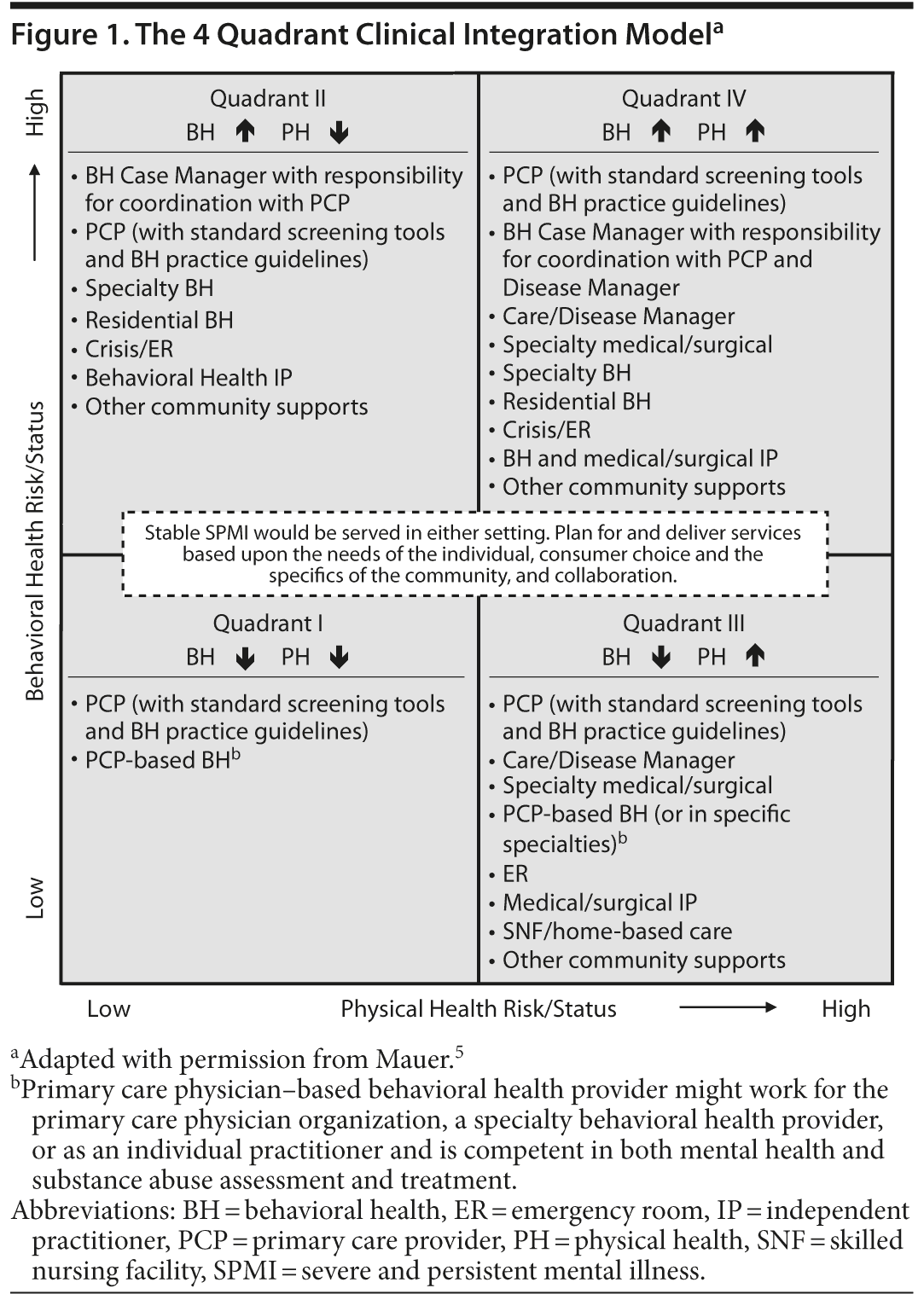This work may not be copied, distributed, displayed, published, reproduced, transmitted, modified, posted, sold, licensed, or used for commercial purposes. By downloading this file, you are agreeing to the publisher’s Terms & Conditions.
Physical diseases are difficult to treat in psychiatric patients, whether they are comorbid disorders or mental disorders due to a general medical condition. The psychiatric symptoms are difficult to treat in a medical ward or clinic, and the physical symptoms are difficult to treat in a psychiatric ward or clinic. For this reason, medical-psychiatric units have been developed but remain uncommon. It has been suggested that assertive community treatment (ACT) teams are a way in which to integrate medical and psychiatric treatments. We review the case of a woman with psychiatric symptoms caused by Graves disease that went untreated due to medication noncompliance and unmanageable irritability, aggression, and mood variability. We make a case for the use of the assertive community treatment team in the treatment of patients with mental disorders due to a general medical condition when the psychiatric manifestations are severe and cannot be managed in a medical ward or clinic.

The Assertive Community Treatment Team: An Appropriate Treatment for Medical Disorders That Present With Prominent Psychiatric Symptoms

ABSTRACT
Physical diseases are difficult to treat in psychiatric patients, whether they are comorbid disorders or mental disorders due to a general medical condition. The psychiatric symptoms are difficult to treat in a medical ward or clinic, and the physical symptoms are difficult to treat in a psychiatric ward or clinic. For this reason, medical-psychiatric units have been developed but remain uncommon. It has been suggested that assertive community treatment (ACT) teams are a way in which to integrate medical and psychiatric treatments. We review the case of a woman with psychiatric symptoms caused by Graves disease that went untreated due to medication noncompliance and unmanageable irritability, aggression, and mood variability. We make a case for the use of the assertive community treatment team in the treatment of patients with mental disorders due to a general medical condition when the psychiatric manifestations are severe and cannot be managed in a medical ward or clinic.
Prim Care Companion CNS Disord 2014;16(4):doi:10.4088/PCC.14br01639
© Copyright 2014 Physicians Postgraduate Press, Inc.
Submitted: February 14, 2014; accepted April 11, 2014.
Published online: July 17, 2014.
Corresponding author: Mary E. Woesner, MD, Department of Psychiatry, Bronx Psychiatric Center, 1500 Waters Place, Bronx, New York 10461 ([email protected]).
In the last decade, there has been continued expansion of the care integration movement, an effort to address the increased morbidity and mortality of persons with severe mental illness through the integration of primary care and behavioral health. Hundreds of programs have evolved and include such model programs as the American Psychiatric Association Gold Award recipient—the Harris County Hospital District Community Behavioral Health Program in Texas1—and others,2,3 including those that are suitable for patients with severe mental illness.4
Many theoretical models of integration exist, including Mauer’s 4 quadrants of clinical integration, based on the patient’s level of medical versus behavioral health needs (Figure 1).5 This concept is 1 of 4 major concepts common to all models of integrated care.4 In Mauer’s model, the needs of the populations in each quadrant advance from low behavioral health and low physical health needs (Quadrant I) to high behavioral health and high physical health needs (Quadrant IV). The complexity of the patients’ needs determines the types of services provided, with Quadrants I/III more likely treated in a primary care setting and Quadrants II/IV requiring an additional specialty mental health setting. This model addresses serious mental health and substance use disorders and is bidirectional, eg, mental health/substance use treatment can be conducted in a primary care context and primary care can be integrated into a specialized mental health/substance use setting.5 Table 1 provides patient examples for each quadrant.
Another integrated health care concept that has potential for transforming primary care, and which has recently gained prominence, is the patient-centered medical home, also known as the patient-centered (or person-centered) health care home. The model organizes health care through a primary care provider team,6 with attention to general and mental health and substance use care. The team provides for all of the patient’s health care needs—prevention, acute and chronic care, and end of life services—either directly or through referrals, and care is coordinated across broader health care and community systems.7 There are currently certification standards for transitioning medical practices into medical homes and programs that adapt the patient-centered medical home model to psychiatry by partnering community health care providers with community mental health centers.
A widely available mode of integration is the assertive community treatment (ACT) team, which originated in the early 1970s at the Mendota Mental Health Institute in Wisconsin.8 The ACT team treats patients with severe mental illness who are noncompliant with outpatient treatment and, therefore, are high users of inpatient and emergency services. The ACT team shares many goals of the medical home but is a specialty mental health system that integrates medical care; medical homes are usually medical practices expanding into substance use and mental health care. The ACT team fits well into the 4-quadrant clinical model because the team treats patients with high behavioral health risk, without (Quadrant II) or with (Quadrant IV) high physical health risk. For example, many of the team’s patients have schizophrenia or bipolar disorder with comorbid cardiovascular disease, diabetes, and/or metabolic syndrome. The ACT team is a multidisciplinary team that provides individualized services to each client by going into the community or the client’s home. The ACT team provides 24/7 care and continuity of care (open-ended, lifelong). The outreach is assertive, and the team persists in the face of failure. Due to a low client-to-staff ratio, the team can provide integrated services, including psychopharmacologic, substance abuse, and rehabilitative treatment; social services; and family services.9 Medical monitoring and collaboration with the primary care treatment team can be added to the integrated services. The presence of nurses on the multidisciplinary ACT team can further improve integration.10

- Hyperthyroidism can exacerbate or mimic bipolar illness.
- When hyperthyroid and mood symptoms co-occur, the integration of medical and psychiatric treatment should be a priority.
- A medical disorder with prominent psychiatric symptoms may benefit from treatment with an assertive community treatment team.
Many of these models evolved from the need to treat psychiatric patients with comorbid medical conditions. There is a smaller cohort of individuals with medical conditions that imitate or exacerbate psychiatric disorders ("mental disorder due to a general medical condition"). Without an integrated approach, these patients cycle between medical and psychiatric treatments. With each hospitalization or office visit, only half of the problem is addressed.
One way to address the psychiatric manifestations of medical illness11-13 is to integrate treatment on an inpatient unit.14 Today, there are medical-psychiatric units throughout the country.15,16 When such a unit is not available and the patient remains in the medical ward or clinic, or when the patient is discharged from a medical-psychiatric unit, treatment can be difficult if the psychiatric symptoms are severe. An ACT team may be an appropriate treatment option. We report on one such case.
CASE REPORT
Ms A is a woman in her 20s who was first diagnosed with Graves disease/hyperthyroidism in her late teens when she presented with a diffuse expanding neck mass, exophthalmos, fatigue, palpitations, irritability, dizziness, and weight loss. She declined a subtotal thyroidectomy and chose treatment with methimazole. There was a family history of Graves disease but no family history of bipolar disorder.
Ms A was assigned to the ACT team at age 19 years following a psychiatric hospitalization precipitated by vaguely described irritability and noncompliance with treatment. While hospitalized, she was given a diagnosis of thyroid disease and bipolar I disorder and was treated with lithium; Ms A did not discuss her thyroid disease with her physician due to a fear of surgery. The medical disorder was not considered in the discharge plan, and thyroid tests were not reported. At the time of discharge, Ms A was refusing psychotropic medication but was no longer symptomatic, which ruled out further inpatient care. The inpatient psychiatrist advised the ACT team to "monitor behavior" and consider a resumption of psychiatric medication if her irritability increased.
For 2 years after assignment to the ACT team, Ms A was followed on a minimum of a weekly basis. She declined all blood work, including thyroid studies. She demonstrated moderate irritability but exhibited no gross hallucinations or delusions and complained of no sleep problems. No medication was prescribed.
After 2 years, Ms A was rehospitalized on a psychiatric unit for symptoms of irritability, agitation, and threatening behavior. During this hospitalization, she was diagnosed with Graves disease/hyperthyroidism. A β-blocker was prescribed to treat her palpitations and mild tachycardia. She was again diagnosed with bipolar disorder and was discharged on risperidone, valproic acid, and methimazole. There was no referral to an endocrinologist. Ms A adhered to her medication regimen during hospitalization but was noncompliant after discharge. The ACT team continued to follow her on more than a weekly basis and educated Ms A and her family on the nature of her condition. A strong alliance formed between Ms A and the team.
Three years later, at age 24 years, Ms A’s weight dropped substantially, and she experienced hyperphagia, hair loss, and moderate irritability. She was noted to be consuming large amounts of caffeinated soda, in the range of 432-648 mg of caffeine/day, exacerbating her anxiety and irritability. The ACT team met with her a number of times per week, and she agreed to have her thyroid function tested. Her thyroid-stimulating hormone level was 0.004 μU/L, compatible with a flare-up of Graves disease. The ACT team arranged transport to a local emergency room and advocated for Ms A’s voluntary admission to a medical unit, where she was treated for a week with methimazole 10 mg/day. Given her history of complying with treatment only while hospitalized, the ACT team advocated for transfer to the inpatient psychiatric unit and remained involved in her care. To reduce irritability and encourage weight gain, 5 mg of olanzapine was given at night. Once her weight increased, Ms A was discharged and remained medication compliant for several weeks.
Soon after discharge, Ms A chose to become pregnant. The ACT team arranged for prenatal care, which she accepted, but she refused to see an endocrinologist. Her prenatal physician reported that, during pregnancy, she was euthyroid, and no thyroid or psychotropic medication was given. Little irritability was observed. Thyroid function tests taken at the time of childbirth were normal. When Ms A was 3 months’ postpartum, her mood was euthymic, and she did not require medication. She continued to reside with her mother, and the ACT team confirmed that the mother was an effective primary caregiver for the child. The ACT team continued to monitor Ms A’s mood, weight, and pulse rate and remained ready to reinstitute treatment. The consensus of the team was that she had Graves disease masquerading as a bipolar disorder.17,18 This diagnosis was based on the temporal association between clinically significant irritability and abnormal thyroid function tests.
DISCUSSION
For years, Ms A went untreated or undertreated and lived with subclinical or clinical hyperthyroidism, leading to persistent irritability and mood symptoms. She required psychiatric hospitalization for agitation and threatening behavior. She required medical hospitalization for significant weight loss, hyperphagia, and irritability. While hospitalized, Ms A was compliant with treatment but stopped medications following discharge. She moved between medical and psychiatric settings as her diagnoses and treatments changed, and this separation of care left the treating facilities with little institutional memory of her condition. In contrast, the ACT team had an advantage: the ACT team provided continuity of care and followed her through inpatient and outpatient treatment, maintaining records—and memory—of her care. As a multidisciplinary team with psychiatric and nursing staff, the ACT team was able to identify early signs of hyperthyroidism, monitor compliance with methimazole and psychotropics, and guide Ms A into treatment before the occurrence of a crisis. Through its integrated services, the ACT team provided substance abuse groups for the treatment of her caffeinism, which was exacerbating anxiety and other symptoms of hyperthyroidism.19 Through its integrated services, the ACT team provided Ms A with counseling on safe sex practices and birth control and arranged for and accompanied her to prenatal and postnatal visits.
Applying Mauer’s model of clinical integration,5 there were times in Ms A’s course when she had both high behavioral health and high physical health needs (Quadrant IV); these patients are best served in primary care and specialty mental health settings. When Ms A was sick at age 24 years, the ACT team effected both medical and psychiatric hospitalization, in the absence of access to a medical-psychiatric unit.
The team also facilitated prenatal and postnatal care, eventual treatment by an endocrinologist, and emergency treatment as needed. At this point, there are no clear mandates for ACT teams on the extent of involvement in medical care. Involvement varies from team to team and patient to patient.
In summary, ACT team placement can be an appropriate treatment for patients with a medical disorder that presents with prominent psychiatric symptoms. As with other types of patients, a history of noncompliance with treatment is a good reason for considering this option.
Drug names: lithium (Lithobid and others), methimazole (Tapazole), olanzapine (Zyprexa), risperidone (Risperdal and others), valproic acid (Depakene, Stavzor, and others).
Author affiliations: Department of Psychiatry, Bronx Psychiatric Center (Drs Woesner and Kanofsky); and Albert Einstein College of Medicine (all authors), Bronx, New York.
Potential conflicts of interest: None reported.
Funding/support: None reported.
Previous presentation: This article derived from a poster presentation at the 165th Annual Meeting of the American Psychiatric Association (APA); May 5-9, 2012; Philadelphia, PA. Subsequent to that meeting, the authors were invited to present and did present the poster "A Case of Graves’ Disease Treated by a Psychiatric ACT Team," at the 64th American Psychiatric Association Institute on Psychiatric Services; October 4-7, 2012; New York, NY.
REFERENCES
1. 2007 APA Gold Award: Integration of community psychiatry into primary care centers in Harris County, Texas. Psychiatr Serv. 2007;58(10):1366-1368. PubMed doi:10.1176/appi.ps.58.10.1366
2. Health Management Associates of Illinois. Integrating publicly funded physical and behavioral health services: a description of selected initiatives final report. Prepared for The Robert Wood Johnson Foundation; February 2007. http://www.healthmanagement.com/files/rwjfreport.pdf. Accessed February 9, 2014.
3. Weaver D. Compendium of Primary Care and Mental Health Integration Activities Across Various Participating Federal Agencies. Rockville, MD: Substance Abuse & Mental Health Services Administration; 2008. http://www.samhsa.gov/Matrix/MHST/Compendium_Mental%20Health.pdf. Updated January 2008. Accessed February 9, 2014.
4. Collins C, Hewson DL, Munger R, et al. Evolving Models of Behavioral Health Integration in Primary Care. New York, NY: Milbank Memorial Fund; 2010. http://www.milbank.org/uploads/documents/10430EvolvingCare/EvolvingCare.pdf Accessed February 9, 2014.
5. Mauer B. Behavioral Health/Primary Care Integration: The Four Quadrant Model and Evidence-Based Practices. Rockville, MD: National Council for Community Behavioral Healthcare; 2002. Revised February, 2006. http://www.iphca.org/Portals/0/SEARCH/Four%20Quadrant%20Model%20updated%202-06.pdf. Accessed March 31, 2014.
6. Donaldson MS, Yordy DY, Lohr KN, et al, eds. Institute of Medicine. Primary Care: America’s Health in a New Era. Washington, DC: National Academies Press; 1996.
7. Patient Centered Primary Care Collaborative. http://www.pcpcc.org/about/medical-home. Accessed March 31, 2014.
8. Test MA, Stein LI. Practical guidelines for the community treatment of markedly impaired patients. Community Ment Health J. 1976;12(1):72-82. PubMed doi:10.1007/BF01435740
9. Bond GR, Drake RE, Mueser KT, et al. Assertive community treatment for people with severe mental illness: critical ingredients and impact on patients. Dis Manag Health Outcomes. 2001;9(3):141-159. doi:10.2165/00115677-200109030-00003
10. Carson Weinstein L, Henwood BF, Cody JW, et al. Transforming assertive community treatment into an integrated care system: the role of nursing and primary care partnerships. J Am Psychiatr Nurses Assoc. 2011;17(1):64-71. PubMed doi:10.1177/1078390310394656
11. Hall RC, Popkin MK, Devaul RA, et al. Physical illness presenting as psychiatric disease. Arch Gen Psychiatry. 1978;35(11):1315-1320. PubMed doi:10.1001/archpsyc.1978.01770350041003
12. Hall RCW, Gardner ER, Stickney SK, et al. Physical illness manifesting as psychiatric disease, II: analysis of a state hospital inpatient population. Arch Gen Psychiatry. 1980;37(9):989-995. PubMed doi:10.1001/archpsyc.1980.01780220027002
13. O’ Brien RF, Kifuji K, Summergrad P. Medical conditions with psychiatric manifestations. Adolesc Med Clin. 2006;17(1):49-77. PubMed
14. Kishi Y, Kathol RG. Integrating medical and psychiatric treatment in an inpatient medical setting: the type IV program. Psychosomatics. 1999;40(4):345-355. PubMed doi:10.1016/S0033-3182(99)71230-2
15. Kathol RG, Harsch HH, Hall RCW, et al. Categorization of types of medical/psychiatry units based on level of acuity. Psychosomatics. 1992;33(4):376-386. PubMed doi:10.1016/S0033-3182(92)71942-2
16. Kathol RG, Stoudemire A. Medical psychiatric units. In: Rundell J, Wise M, eds. Textbook of Consultation-Liaison Psychiatry. 2nd ed. Washington, DC: American Psychiatric Press; 2002.
17. Lee S, Chow CC, Wing YK, et al. Mania secondary to thyrotoxicosis. Br J Psychiatry. 1991;159(5):712-713. PubMed doi:10.1192/bjp.159.5.712
18. Bunevicius R, Velickiene D, Prange AJ Jr. Mood and anxiety disorders in women with treated hyperthyroidism and ophthalmopathy caused by Graves’ disease. Gen Hosp Psychiatry. 2005;27(2):133-139. PubMed doi:10.1016/j.genhosppsych.2004.10.002
19. Clozel M, Branchaud CL, Tannenbaum GS, et al. Effect of caffeine on thyroid and pituitary function in newborn rats. Pediatr Res. 1983;17(7):592-595. PubMed doi:10.1203/00006450-198307000-00015
This PDF is free for all visitors!






